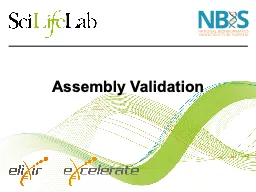

What is an assembly 2 Basic assembly statistics Percentage of assembly in scaffolded contigs 42 Percentage of assembly in unscaffolded contigs ID: 911565
Download Presentation The PPT/PDF document "Asse mbly Validation Assembly" is the property of its rightful owner. Permission is granted to download and print the materials on this web site for personal, non-commercial use only, and to display it on your personal computer provided you do not modify the materials and that you retain all copyright notices contained in the materials. By downloading content from our website, you accept the terms of this agreement.
Slide1
Assembly Validation
Slide2Assembly
What is an assembly?2
Slide3Basic assembly statistics
Percentage of assembly in
scaffolded contigs 4.2%
Percentage of assembly in
unscaffolded
contigs
95.8%
Average number of
contigs
per scaffold 1.0
Average length of break (>25 Ns) between contigs
in scaffold 191
Number of contigs 9082
Number of contigs
in scaffolds 72 Number of
contigs not in scaffolds 9010 Total size of contigs
22857451 Longest contig 621740
Shortest contig 56 Number of
contigs > 1K nt 2527 27.8% Number of
contigs > 10K nt 329 3.6%
Number of
contigs
> 100K
nt
34 0.4%
Number of
contigs
> 1M
nt
0 0.0%
Number of
contigs
> 10M
nt
0 0.0%
Mean
contig
size 2517
Median
contig
size 571
N50
contig
length 25795
L50
contig
count 158
NG50
contig
length 188047
LG50
contig
count 8
N50
contig
- NG50
contig
length difference 162252
contig
%A 28.57
contig
%C 21.46
contig
%G 21.39
contig
%T 28.58
contig
%N 0.01
contig
%non-ACGTN 0.00
Number of
contig
non-ACGTN
nt
0
Slide4Basic assembly statistics
Longest contig 621740
Shortest contig 56
Number of
contigs
> 1K
nt
2527 27.8%
Number of contigs
> 10K nt 329 3.6%
Number of
contigs > 100K nt
34 0.4%
Number of contigs > 1M
nt 0 0.0% Number of
contigs > 10M nt 0 0.0%
Mean contig size 2517
Median contig size 571
N50 contig length 25795
L50
contig
count 158
NG50 contig length 188047 LG50 contig count 8
Poor Assembly.Many contigs< 1kb
Slide5Basic assembly statistics
N50 is a common statistical measure of sequence length.The size of the smallest contig in the set of largest contigs that make up 50% of the assembly size.
50
4
0
2
0
2
0
10
50 + 40 + 20 + 20 + 10 = 140
N50 = 40
Slide6Basic assembly statistics
N50 has some disadvantages thoughN50 is not a measure of assembly correctnessIt only measures sequence contiguity
N50 is not meaningful for different assembly sizes.It’s not comparable across species, and technically even the same genome.N50 does not improve for near complete assemblies.
Once you have good scaffolds, only small
contigs
remain.
N50 is biased if short sequences are excluded.
Often shorter
contigs
are filtered out from the assembly.
Slide7Basic assembly statistics
A better statistic is NG50The size of the smallest contig in the set of largest contigs that make up 50% of the (estimated)
genome size (not assembly).It is still only a measure of sequence contiguity, but comparable for the same genome.There is still a limit on when it will not improve further.
Smaller
contigs
can be filtered out without affecting the value.
Slide8Basic assembly statistics
Tool: QuastProduces comparisons of assembliesStatistics include number of contigs
, N50, NG50, GC content
Slide9Assembly completenessK-
mer Analysis ToolkitK-mer comparison plots indicate how well the genome is assembled.
Poor - Many high frequency are k-
mers
missing from the assembly
Good - Most high frequency are found in the assembly
Slide10Assembly completenessK-
mer Analysis Toolkit
Good
Bad
Slide11Assembly completeness
Samtools flagstat <bamfile>
27190072 + 0 in total (QC-passed reads + QC-failed reads)0 + 0 secondary
584370 + 0 supplementary
0 + 0 duplicates
25987447 + 0 mapped (95.58% : N/A)
26605702 + 0 paired in sequencing
13302851 + 0 read1
13302851 + 0 read2
23321920 + 0 properly paired (87.66% : N/A)
25250050 + 0 with itself and mate mapped
153027 + 0 singletons (0.58% : N/A)1196126 + 0 with mate mapped to a different
chr
439746 + 0 with mate mapped to a different chr (
mapQ>=5)
Slide12Read alignment properties
Aligning reads back to the draft assembly tells us about data congruency.Which areas of the assembly have no / reduced coverage?Do paired reads align to different
contigs?Do paired reads align to close or too far apart?Do paired reads align in the wrong orientation?
Slide13Read alignment properties
Coverage tracks show poor coverage
No read support
IGV - Genome Browser
Slide14Read alignment properties
22kb
contig35kb read Softpadded bases in alignment
Slide15Read alignment properties
Bases in disagreement
Read pairs are inconsistent
Slide16Read alignment properties
Downstream processing assumes correct assemblyRepeats and heterozygosity complicate assembly, however misassemblies are a primary reason for failing to improve assemblies further.
This
misassembly
prevents the
contigs
from being
scaffolded
correctly
Slide17Read alignment properties
Slide18Read alignment properties
FRCBam
Slide19Read alignment properties
FRCBamFeature Response Curve (only comparable if estimated genome size is used).The best assembly has the least features.
Slide20Read alignment properties
TigMint
Slide21Correcting an assembly
Manually breaking a contig
ProgramsReapr[GAP5]
[
QuickMerge
]
[
BIGMAC]
Slide22SummaryAssembly statistics are a good starting point
N50, NG50 is not a measure of accuracy or qualityK-mer comparisons of reads
vs assembly inform completeness, and qualityRead alignment properties inform completeness, accuracy, and quality.Check for
misassemblies
.